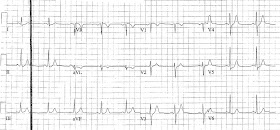He is alert and orientated with a normal blood pressure.
You can check out the comments on our original post here.
 |
| Click to enlarge |
Rate:
- Mean ventricular rate ~260 bpm
- Variable rate up to 300 bpm
- Irregular rhythm
- Indeterminate
- QRS - Broad with variable width
- RBBB Morphology in lead V1
- Atrial Fibrillation in the setting of pre-excitation / WPW
- Irregular
- Very fast
- Variable QRS width
Why is this important ?
We've covered another example of pre-excited AF nearly 2 years ago (ECG of the Week 28th October 2013) and I'm going to repeat myself again now.
This is a clinical situation in which significant harm to the patient can occur if the ECG features are not recognised and acted on appropriately.
The concern with pre-excited AF is the ability for the accessory pathway to conduct at much higher rates than the AV node with the potential for degeneration into ventricular fibrillation.
It is for this reason that any drugs which block the AV node are ABSOLUTELY CONTRAINDICATED in this scenario including adenosine, calcium-channel blockers, beta-blockers and digoxin. If the AV node is blocked then there is increased conduction via the accessory pathway which may precipitate ventricular fibrillation.
- Put simply if you give the patient AV nodal blocking drugs you might kill them.
The safest and easiest method to restore sinus rhythm is synchronised cardioversion.
If you have a patient you are concerned about the risks of sedation for cardioversion I would suggest getting expert assistance from anaesthetics and urgent cardiology advice on how to proceed.
Chemical cardioversion is a possible alternative in stable patients with iv procainamide being the commonly used agent. This drug is not readily available in Australia, and I personally have no experience using it.
Amiodarone is available in Australia although it's utility in the treatment of stable AF with WPW is controversial. The Australian Resuscitation Council Guideline 11.9 Managing Acute Dysrhythmias states that 'Amiodarone may be considered for hemodynamically stable patients with AF involving conduction over an accessory pathway' [Class C, LoE III-2]. This statement should be tempered against case reports of potential harm, see the paper below:
- Tijunelis MA, Herbert ME. Myth: Intravenous amiodarone is safe in patients with atrial fibrillation and Wolff-Parkinson-White syndrome in the emergency department. CJEM. 2005 Jul;7(4):262-5. PMID: 17355684 Full text
I'll repeat the statement above that synchronised DC cardioversion is the safest method for treating stable and unstable pre-excited atrial fibrillation; if chemical cardioversion is being considered then urgent cardiology advice is required.
Remember all these patients must be referred to cardiology services for EP follow-up and consideration for ablation.
What happened ?
The patient underwent synchronised DC cardioversion and his post cardioversion ECG is below.
 |
| Click to enlarge PR shortening and subtle delta wave in the inferior leads |
References / Further Reading
Life in the Fast Lane
Textbook
- Chan TC, Brady WJ, Harrigan RA, Ornato JP, Rosen P. ECG in Emergency Medicine and Acute Care. Elsevier Mosby 2005.
No comments:
Post a Comment